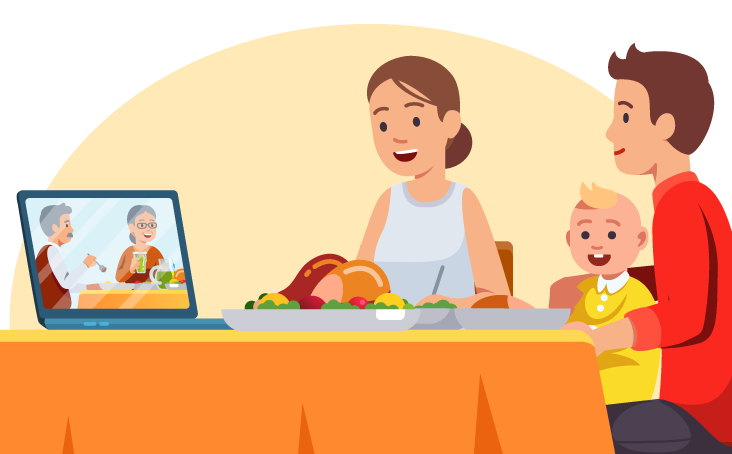The COVID-19 pandemic has been stressful and isolating for many people. Gatherings during the upcoming holidays can be an opportunity to reconnect with family and friends. This holiday season, consider how your holiday plans can be modified to reduce the spread of COVID-19 to keep your friends, families, and communities healthy and safe.
More than 1 million COVID-19 cases were reported in the United States over the last 7 days. As cases continue to increase rapidly across the United States, the safest way to celebrate Thanksgiving is to celebrate at home with the people you live with, according to the CDC.
Gatherings with family and friends who do not live with you can increase the chances of getting or spreading COVID-19 or the flu.
CDC offers the following considerations to slow the spread of COVID-19 during small gatherings. These considerations are meant to supplement—not replace—any state, local, territorial, or tribal health and safety laws, rules, and regulations with which all gatherings must comply.
Considerations for Small Gatherings of Family and Friends
Celebrating virtually or with members of your own household (who are consistently taking measures to reduce the spread of COVID-19) poses the lowest risk for spread. Your household is anyone who currently lives and shares common spaces in your housing unit (such as your house or apartment). This can include family members, as well as roommates or people who are unrelated to you. People who do not currently live in your housing unit, such as college students who are returning home from school for the holidays, should be considered part of different households. In-person gatherings that bring together family members or friends from different households, including college students returning home, pose varying levels of risk.
Organizers and attendees of larger events should consider the risk of virus spread based on event size (number of attendees and other factors) and take steps to reduce the possibility of infection, as outlined in the Considerations for Events and Gatherings.
Several factors can contribute to the risk of getting and spreading COVID-19 at small in-person gatherings. In combination, these factors will create various amounts of risk:
- Community levels of COVID-19 – High or increasing levels of COVID-19 cases in the gathering location, as well as in the areas where attendees are coming from, increase the risk of infection and spread among attendees. Family and friends should consider the number of COVID-19 cases in their community and in the community where they plan to celebrate when deciding whether to host or attend a gathering. Information on the number of cases in an area can often be found on the local health department website.
- Exposure during travel – Airports, bus stations, train stations, public transport, gas stations, and rest stops are all places travelers can be exposed to the virus in the air and on surfaces.
- Location of the gathering – Indoor gatherings, especially those with poor ventilation (for example, small enclosed spaces with no outside air), pose more risk than outdoor gatherings.
- Duration of the gathering – Gatherings that last longer pose more risk than shorter gatherings. Being within 6 feet of someone who has COVID-19 for a cumulative total of 15 minutes or more greatly increases the risk of becoming sick and requires a 14-day quarantine.
- Number and crowding of people at the gathering – Gatherings with more people pose more risk than gatherings with fewer people. CDC does not have a limit or recommend a specific number of attendees for gatherings. The size of a holiday gathering should be determined based on the ability of attendees from different households to stay 6 feet (2 arm lengths) apart, wear masks, wash hands, and follow state, local, territorial, or tribal health and safety laws, rules, and regulations.
- Behaviors of attendees prior to the gathering – Individuals who did not consistently adhere to social distancing (staying at least 6 feet apart), mask wearing, handwashing, and other prevention behaviors pose more risk than those who consistently practiced these safety measures.
- Behaviors of attendees during the gathering – Gatherings with more safety measures in place, such as mask wearing, social distancing, and handwashing, pose less risk than gatherings where fewer or no preventive measures are being implemented. Use of alcohol or drugs may alter judgment and make it more difficult to practice COVID-19 safety measures.
The following people should not attend in-person holiday gatherings
People with or exposed to COVID-19
Do not host or participate in any in-person gatherings if you or anyone in your household
Do not host or attend gatherings with anyone who has COVID-19 or has been exposed to someone with COVID-19 in the last 14 days.
People at increased risk for severe illness
If you are an older adult or person with certain medical conditions who is at increased risk of severe illness from COVID-19, or live or work with someone at increased risk of severe illness, you should avoid in-person gatherings with people who do not live in your household.
Hosting a Thanksgiving Gathering
Celebrating virtually or with the people you live with is the safest choice this Thanksgiving.
If having guests to your home, be sure that people follow the steps that everyone can take to make Thanksgiving safer. These steps include:
- Have a small outdoor meal with family and friends who live in your community.
- Limit the number of guests.
- Have conversations with guests ahead of time to set expectations for celebrating together.
- Clean and disinfect frequently touched surfaces and items between use.
- If celebrating indoors, bring in fresh air by opening windows and doors, if possible. You can use a window fan in one of the open windows to blow air out of the window. This will pull fresh air in through the other open windows.
- Limit the number of people in food preparation areas.
- Have guests bring their own food and drink.
- If sharing food, have one person serve food and use single-use options, like plastic utensils.
Everyone Can Make Thanksgiving Safer
Wear a mask
- Wear a mask with two or more layers to help protect yourself and others from COVID-19.
- Wear the mask over your nose and mouth and secure it under your chin.
- Make sure the mask fits snugly against the sides of your face.
Stay at least 6 feet away from others who do not live with you
Consider Other Thanksgiving Activities
Host a virtual Thanksgiving meal with friends and family who don’t live with you

- Schedule a time to share a meal together virtually.
- Have people share recipes and show their turkey, dressing, or other dishes they prepared.
Watch television and play games with people in your household
- Watch Thanksgiving Day parades, sports, and movies at home.
Things to do
The Macy’s Thanksgiving Day Parade 2020 (virtual)
The 15 best Thanksgiving movies
Play games
Still Thinking about Traveling?
Travel may increase your chance of getting and spreading COVID-19. Postponing travel and staying home is the best way to protect yourself and others this year.
If you are considering traveling for Thanksgiving, here are some important questions to ask yourself and your loved ones beforehand. These questions can help you decide what is best for you and your family.
- Are you, someone in your household, or someone you will be visiting at increased risk for getting very sick from COVID-19?
- Are cases high or increasing in your community or your destination? Check CDC’s COVID Data Tracker for the latest number of cases.
- Are hospitals in your community or your destination overwhelmed with patients who have COVID-19? To find out, check state and local public health department websites.
- Does your home or destination have requirements or restrictions for travelers? Check state and local requirements before you travel.
- During the 14 days before your travel, have you or those you are visiting had close contact with people they don’t live with?
- Do your plans include traveling by bus, train, or air which might make staying 6 feet apart difficult?
- Are you traveling with people who don’t live with you?
If the answer to any of these questions is “yes,” you should consider making other plans, such as hosting a virtual gathering or delaying your travel.
It’s important to talk with the people you live with and your family and friends about the risks of traveling for Thanksgiving.
If you do travel



